One & One Green Technologies stock soars 100% after IPO debut
Introduction & Market Context
Kongsberg Automotive (OL:KOA) presented its Q2 2025 earnings results on August 12, 2025, revealing continued challenges amid a difficult market environment. The automotive components supplier reported declining revenues and negative operating income, while simultaneously announcing significant strategic initiatives aimed at repositioning the company for future growth.
The presentation, delivered by President & CEO Trond Fiskum and CFO Erik Magelssen, highlighted both immediate financial challenges and longer-term strategic moves, including cost reduction programs, organizational restructuring, and a strategic acquisition in the growing steer-by-wire technology space.
Quarterly Performance Highlights
Kongsberg Automotive reported Q2 2025 revenues of 192.4 MEUR, representing an 8.1% decline compared to Q2 2024 (209.3 MEUR). The company attributed this revenue drop to weaker market conditions and negative currency impacts. More concerning was the EBIT figure, which fell to -1.5 MEUR from 6.4 MEUR in the same quarter last year.
As shown in the following financial overview:
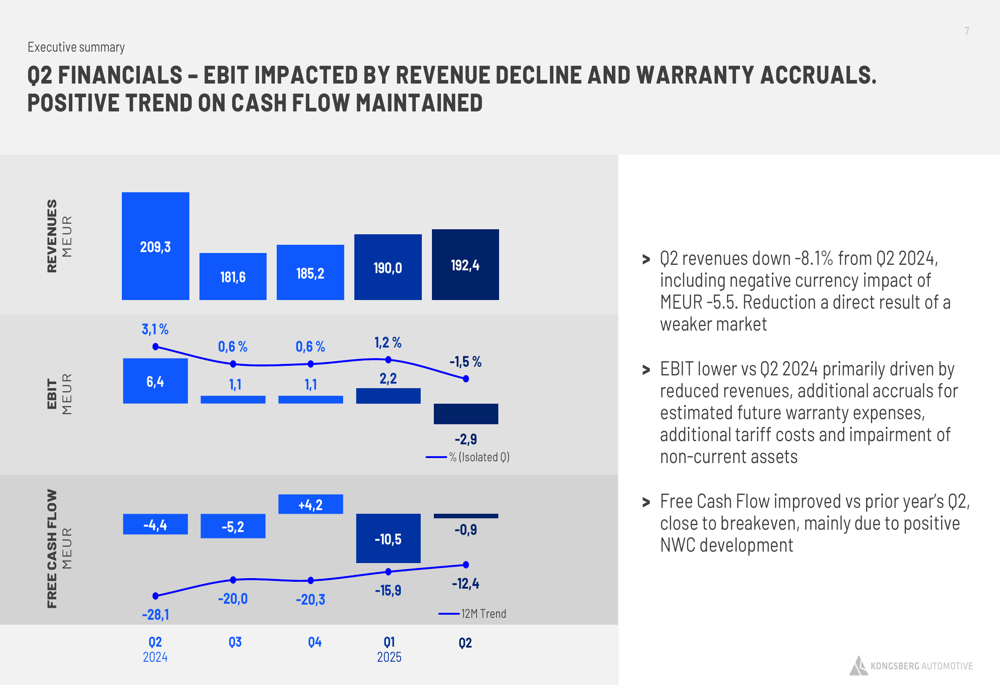
Free cash flow showed improvement at -0.9 MEUR, compared to -4.4 MEUR in Q2 2024, bringing the company close to cash flow breakeven despite the challenging operating environment.
The performance diverged significantly between Kongsberg’s two business segments. Flow Control Systems performed relatively well with revenues of 82.2 MEUR and an EBIT margin of 8.3%, benefiting from higher sales in European and North American commercial vehicle markets. In contrast, Drive Control Systems struggled with revenues of 81.5 MEUR and a negative EBIT margin of -15.1%, impacted by warranty accruals, tariffs, and declining sales in key markets.
Strategic Initiatives
Kongsberg Automotive announced several strategic initiatives aimed at improving profitability and positioning the company for future growth. Central to these efforts is an expanded cost reduction program targeting over 42 MEUR in annual savings, expected to improve EBIT by 4-5% with stable revenues.
The comprehensive cost reduction plan includes:
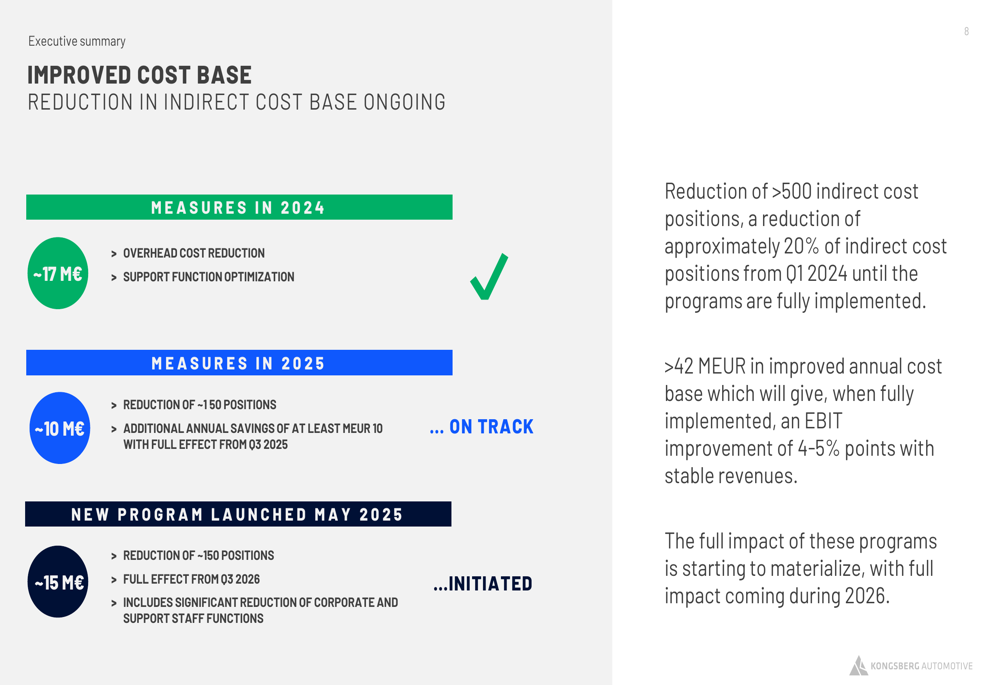
The company is also implementing significant structural changes, including a new organizational structure that strengthens the two business areas with full P&L responsibility while eliminating or merging various corporate functions.
As illustrated in the new company structure:

In a move to enhance operational efficiency, Kongsberg announced the closure of its Zurich office by March 31, 2026, with functions being scaled down and transitioned to other locations. Additionally, the company plans to consolidate its Swedish operations by closing the Ljungsarp plant and moving operations to Mullsjö by Q3 2026.
Perhaps the most significant strategic development is the acquisition of Chassis Autonomy, a Swedish company specializing in steer-by-wire technology with 31 patents. This acquisition positions Kongsberg in a market projected to grow to 3.5 billion EUR by 2035.
As detailed in the strategic acquisition overview:
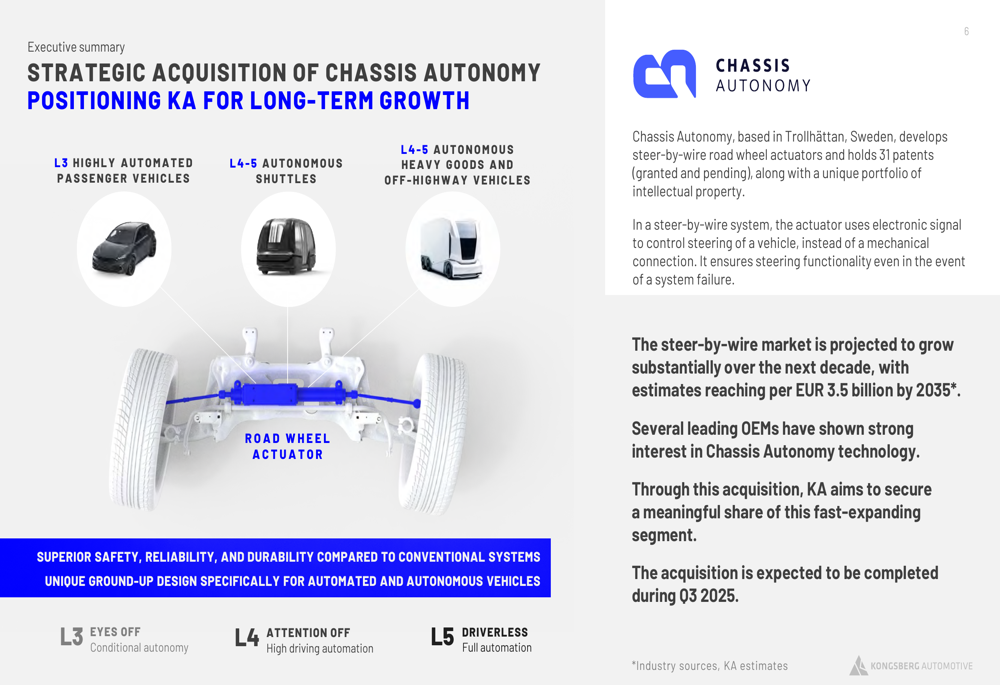
The company also strengthened its position in China by acquiring the remaining 25% of shares in its joint venture, Kongsberg Automotive Morse Shanghai Co. Ltd., taking full ownership to drive growth in the Chinese truck and bus market.
Detailed Financial Analysis
A deeper look at Kongsberg’s financial performance reveals several factors contributing to the EBIT decline. The EBIT bridge analysis shows that lower volumes, warranty accruals, and tariff impacts were the primary drivers of the deterioration:

The company’s free cash flow, while still negative, showed significant improvement compared to both Q2 2024 and Q1 2025:
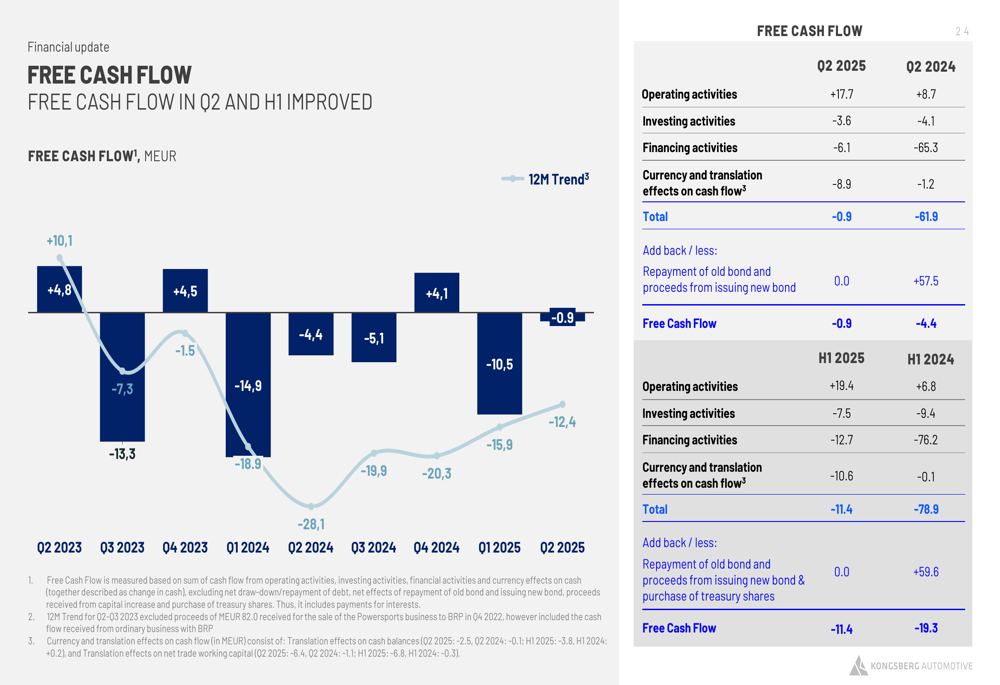
Tariffs continue to impact Kongsberg’s performance, with tariff costs in Q2 2025 amounting to approximately 2.7 MEUR, of which only 0.7 MEUR was reimbursed by customers. The company expects to recover close to 100% of these costs eventually but notes that the primary negative consequence remains the impact on overall market demand, especially in the US.
Despite these challenges, Kongsberg reported 91.1 MEUR in new business wins during Q2 2025, including a notable contract for a Dog Clutch Actuator in the fast-growing EV segment, estimated to generate 20 MEUR in lifetime revenue.
Forward-Looking Statements
The outlook for Kongsberg Automotive remains challenging in the near term. For H2 2025, the company expects revenues to fall below both H1 2025 and H2 2024 levels, reflecting continued market weakness. However, management projects that the EBIT margin for H2 2025 will surpass both H1 2025 and H2 2024 levels, supported by continued cost savings and operational efficiencies.
The company’s summary of key priorities emphasizes:
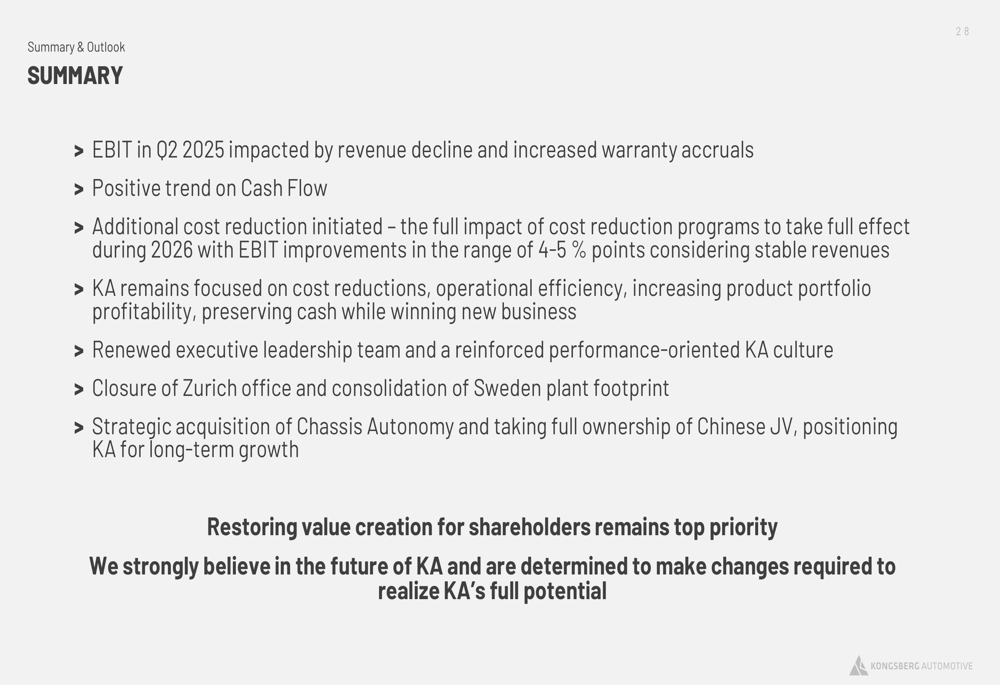
Looking further ahead, Kongsberg sees a more positive market outlook for 2026, suggesting that the current restructuring efforts are designed to position the company for recovery when market conditions improve.
This quarter’s results represent a continuation of the challenges seen in Q1 2025, when the company reported a 10.9% year-over-year revenue decline and significantly reduced EBIT. While management had previously indicated potential upside in the second half of 2025, the current outlook has been revised downward, reflecting persistent market headwinds.
Kongsberg Automotive’s next financial report is scheduled for November 5, 2025, when the company will release its Q3 2025 results.
Full presentation:
This article was generated with the support of AI and reviewed by an editor. For more information see our T&C.
